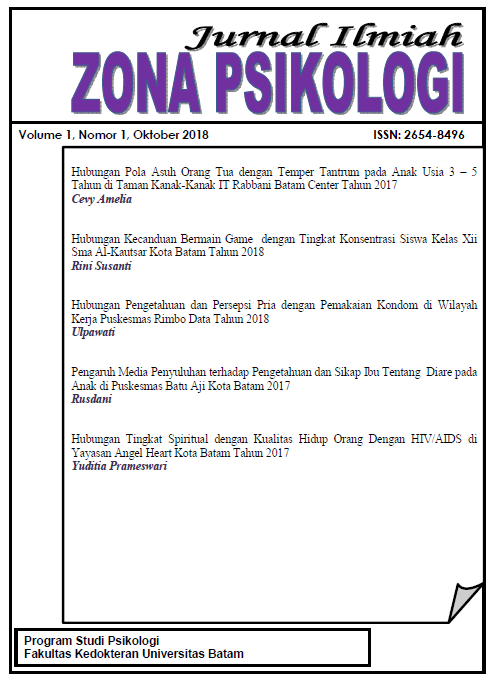HUBUNGAN PENGETAHUAN DAN PERSEPSI PRIADENGANPEMAKAIAN KONDOM DI WILAYAH KERJA PUSKESMAS RIMBO DATA TAHUN 2018
DOI:
https://doi.org/10.37776/jizp.v1i1.26Abstract
A condom is a sheath made of latex due to the penis in an erection or vaginal state that acts as a protector to prevent cement or pre-ejaculatory fluid at the time of the penis in the vagina. Male participation in Family Planning program is quite low. This resulted in men's participation using condom contraception also reduced. The purpose of this study was to determine the Relationship of Knowledge and Perception of Men with Condom Use in the working area of Rimbo Health Center. This research is a type of quantitative research with descriptive analytic design and cross sectional approach done in January 2018. Sampling technique is purposive sampling with total sample as much 80 people. Data were analyzed univariat and bivariate with computer using chi square statistic test. The results were obtained from 80 samples, based on this univariate analysis (46,2%) had low knowledge, 53,8% had negative perception, and most (63,8%) did not use condom contraception. Based on bivariate analysis, there is a significant relationship between male knowledge with condom use and p value = 0,000 <0,05. Men's perception with condom usage states that there is a significant correlation between perception with condom use and p value = 0,000 <0,05. It is expected that the results of this study can increase knowledge and perception of the community through counseling, especially about condom contraception. Based on the results of this study can be concluded that there is a relationship Knowledge and Perception of Men with Condom Use in the work area Rimbo Data Puskesmas.References
Arikunto, S. (2002). Prosedur Penelitian Suatu Pendekatan Praktik. Jakarta: Rineka Cipta
Badan Pusat Statistik, (2004). Jawa Tengah Tahun Dalam Angka. BPS Jawa Tengah, Semarang.
BKKBN. (2006). Anak Indonesia Rentan Pornografi. Diunduh: 12 juni 2017. http://www.bkkbn.go.id/Webs/ DetailRubrik.php?MyID=514.
BKKBN.. (2008).Program MKET. Diakses tanggal 21 juli 2017 www.bkkbn.go.id
BKKBN. (2010) .Sensus Penduduk Tahun 2010.Diakses tanggal 8 juni 2017 htttp://bkkbn.go.id/sensus penduduk
BKKBN. (2011). Pembangunan Kependudukan dan KB BKKBN Provinsi JawaTengah. Jawa Tengah : BKKBN Provinsi
Depkes, RI. (2006). Pedoman Petugas Fasilitatif Pelayanan Keluarga Berencana.Jakarta: Depkes RI
BKKBN. (2012). Data Pemakaian Kondom. Jakarta: Depkes RI.
Erfandi. 2009. Pengetahuan Dan Faktor-Faktor Yang Mempengaruhi. Diunduh 17 Juli 2017. http://forbetterhealth.wordpress.com/2009/04/19/ pengetahuan-dan-faktor-faktor-yang-mempengaruhi.
Handayani, S. (2010). Buku Ajar Pelayanan Keluarga Berencana. Yogyakarta: Pustaka Rihama
Hidayat. (2007). Metode Penelitian Kebidanan dan Teknik Analisa Data. Jakarta: Salemba Medika.
Kusmarjadi (2009).“kontrasepsi http://www.drdidispog.com/2008/04/kontrasepsi-komplit-plit-plit.html. Diakses tanggal 21 juni 2017.
Notoatmodjo, S.. (2014). Ilmu Perilaku Kesehatan. Jakarta: Rineka Cipta.
BKKBN. (2013). Pendidikan dan Perilaku Kesehatan. Jakarta: PT. Rineka Cipta, Jakarta.
BKKBN. (2007). Pendidikan dan Perilaku Kesehatan. Jakarta: Rineka Cipta.
BKKBN. (2010). Metode Penelitian Kesehatan. Jakarta: Rineka Cipta.
BKKBN. (2003), Pengembangan Sumber Daya Manusia, PT Rineka Cipta, Jakarta
Puspitasari, D. (2009). “Faktor Intrinsik yang mempengaruhi Kebiasaan Pemakaian Kondom Pada Wanita Penjaja Seks Liar (Di tangkis porong sidoarjo pada tahun 2009)â€. http://adln.lib.unair.ac.id/files/disk1/251/gdlhub-gdl-s1-2010-puspitar-12516-fkm114-k.pdf. Diakses tanggal 17 juni 2017.
Riset Kesehatan Dasar (Riskesdas). (2013). Badan Penelitian dan Pengembangan Kesehatan Kementerian RI tahun 2013.Diakses: 19 juli 2017, dari http://www.depkes.go.id/resources/download/general/Hasil%20Riskesdas%20 2013.pdf.
Saifuddin, A. (2005). Sikap manusia: Teori dan Pengukurannya. Yogyakarta: Puataka Pelajar.
Saifuddin, A. (2011). Metode Penelitian. Yogyakarta: Pustaka Pelajar.
Sugihartono, dkk (2007) Psikologi Pendidikan, Yogyakarta : UNY Press
Suharman. (2005). Psikologi Kognitif. Surabaya: Srikandi.
United Nations Development Programme. (2013). Summary Human Development Report 2013, New York : 1 UN Plaza.
Waidi. (2006). The Art of Re-engineering Your Mind for Success. Jakarta: Gramedia.
WHO (2014). Commission on Ending Childhood Obesity. Geneva, World Health Organization, Departement of Noncommunicable disease surveillance.
Saifuddin, A. (2004). The World Health Report 2004.http://www.who.int/healthinfo/statisc/mortestimateofdeathbycause/enindex.html. diakses 1 juni 2017.
Wulansari. (2007), Ragam Metode Kontrasepsi, EGC, Jakarta
Yashinta. (2009).Keluarga Berencana. Diakses pada tanggal 5 juli 2017 http://yashinta.blogspot.com
Yusnita, I. (2013). Persepsi Pria dengan Pemakaian Kondom di Dinas Kesehatan Kabupaten Langkat. Diakses tanggal 09 Desember 2017.
Downloads
Published
Issue
Section
License
Manuskrip yang diserahkan penulis haruslah sebuah karya yang tidak melanggar hak cipta (copyright) yang ada. Naskah yang dimasukkan harus yang belum pernah diterbitkan dan tidak dikirimkan pada waktu yang bersamaan kepada penerbit lain. Hak cipta atas semua material termasuk yang berbentuk cetak, elektronik dan bentuk lainnya dipegang oleh Jurnal Ilmiah Zona Psikologi. Setelah manuskrip telah melewati proses penyuntingan substansi dan positif diterima, penulis mengirimkan berkas Pernyataan Hak Cipta ke alamat redaksi Jurnal Ilmiah Zona Psikologi.




